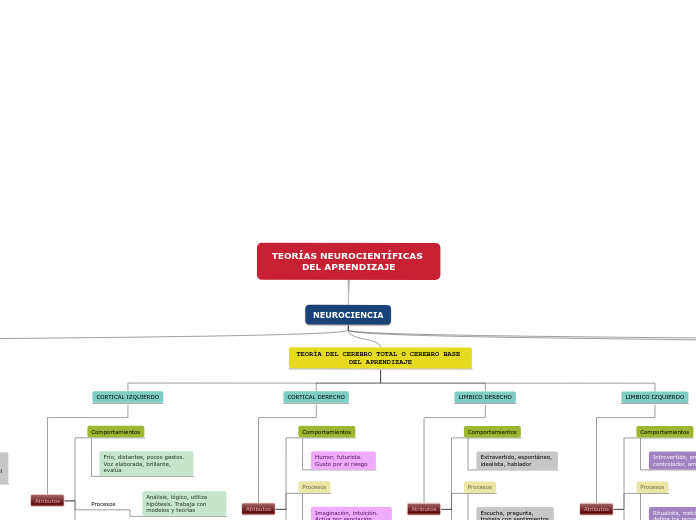da Efraín Fernández mancano 4 anni
1068
TEORÍAS NEUROCIENTÍFICAS DEL APRENDIZAJE

da Efraín Fernández mancano 4 anni
1068

Più simili a questo
Type in the name of the multiple-perspectives text.
Example: Bridge to Terabithia by Katherine Paterson
Identify an important issue from the text that is being presented from different angles. Type it in.
Example: Jesse's drawing talent.
Decide on the fourth point of view
Type in the name of the last character whose perspective on the issue you are going to present.
Example: Leslie Burke, Jesse's new next-door neighbor, and best friend.
Point of view
Type in a relevant quote that highlights the character's point of view. Try to follow a citation format: author's name, chapter, and page.
Example: I can't get the poetry of the trees,' he said. She nodded. Don't worry,' she said. You will someday. He believed her.' (Paterson, 4. 24)
Whose character does the third point of view belong to?
Type in his/her name.
Example: Mr. Aarons, Jesse's father.
Artísticas, sintéticas
Percepción tridimensional, sentido musical, creatividad, sentimientos.
Memorístico, sensorial, espacial, intuitivo, dominio de la izquierda., holístico, sintético, subjetivo.
What does the character think, say or do that suggests their perspective on the issue?
Type in a quote and try to maintain the citation format.
Example: 'He would like to show his drawings to his dad, but he didn't dare. (...) He'd thought his dad would be pleased. He wasn't. What are they teaching in that damn school? he had asked.' (Paterson, 2.8)
What kind of narration introduces the viewpoint?
Choose an answer:
Matemáticas, finanzas, técnicas, investigación.
Habilidad numérica, científica, lenguaje hablado, razonamiento.
Lógico, secuencial, racional, dominio de la mano derecha. Analítico, lingüístico, objetivo, coherente.
Decide on the second point of view
Name the character (it can either be the main character or one of the supporting characters) whose point of view you are presenting.
Example: Miss Edmunds, Jesse's music teacher.
Trabajador, orador, puesta en marcha.
Ritualista, metódico, define los procesos.
Introvertido, emotivo, controlador, ama el poder
Enseña, trabajo en equipo, diálogo, contacto humano.
Escucha, pregunta, trabaja con sentimientos
Extravertido, espontáneo, idealista, hablador
Innovación, artista, visión de futuro
Imaginación, intuición. Actúa por asociación.
Humor, futurista. Gusto por el riesgo
Type in a quote that points out the character's position about the issue.
Try to follow a citation format: author's name, chapter, and page.
Example: 'She said he was unusually talented, and she hoped he wouldn't let anything discourage him.' (Paterson, 2. 8)
Atributos
How is the viewpoint introduced in the story?
Choose an answer:
Competencias
Matemáticas, cuantitativo, finanzas, técnicas
Procesos
Análisis, lógico, utiliza hipótesis. Trabaja con modelos y teorías
Comportamientos
Frío, distantes, pocos gestos. Voz elaborada, brillante, evalúa
Decide on the first point of view you are going to present.
Type in the name of the character (it can either be the main character or one of the supporting characters) whose point of view belongs to.
Example: Jesse Oliver Aarons, Jr., the main character of the novel, a fifth-grader living in a rural Southern area.
Dan razón de los valores, rutinas, costumbres, hábitos y patrones de comportamiento del ser humano.
Cerebro básico
Proceso
Se dan procesos emocionales, estados de calidez, amor, gozo, depresión, odio, entre otros y procesos relacionados con las motivaciones básicas.
Formado por:
Hipocampo
Región Septal
Bulbos
Amígdala
Tálamo
Type in a relevant quote that highlights the character's point of view towards
NEUROCIENCIA.
Try following a citation format: author's name, chapter, and page.
Example: 'Jesse drew the way some people drank whiskey. (...) Lord, he loved to draw. (...) When he was in first grade, he told his father that he wanted to be an artist when he grew up.' (Paterson, 2. 7)
Hemisferio Derecho
Asociados con la posibilidad globalidades y establecer relaciones espaciales.
Procesos asociativos, imaginativos y creativos.
Hemisferio Izquierdo
Descomposición de un todo en sus partes.
Funciones de análisis y síntesis.
Asociado a procesos de razonamiento lógico.